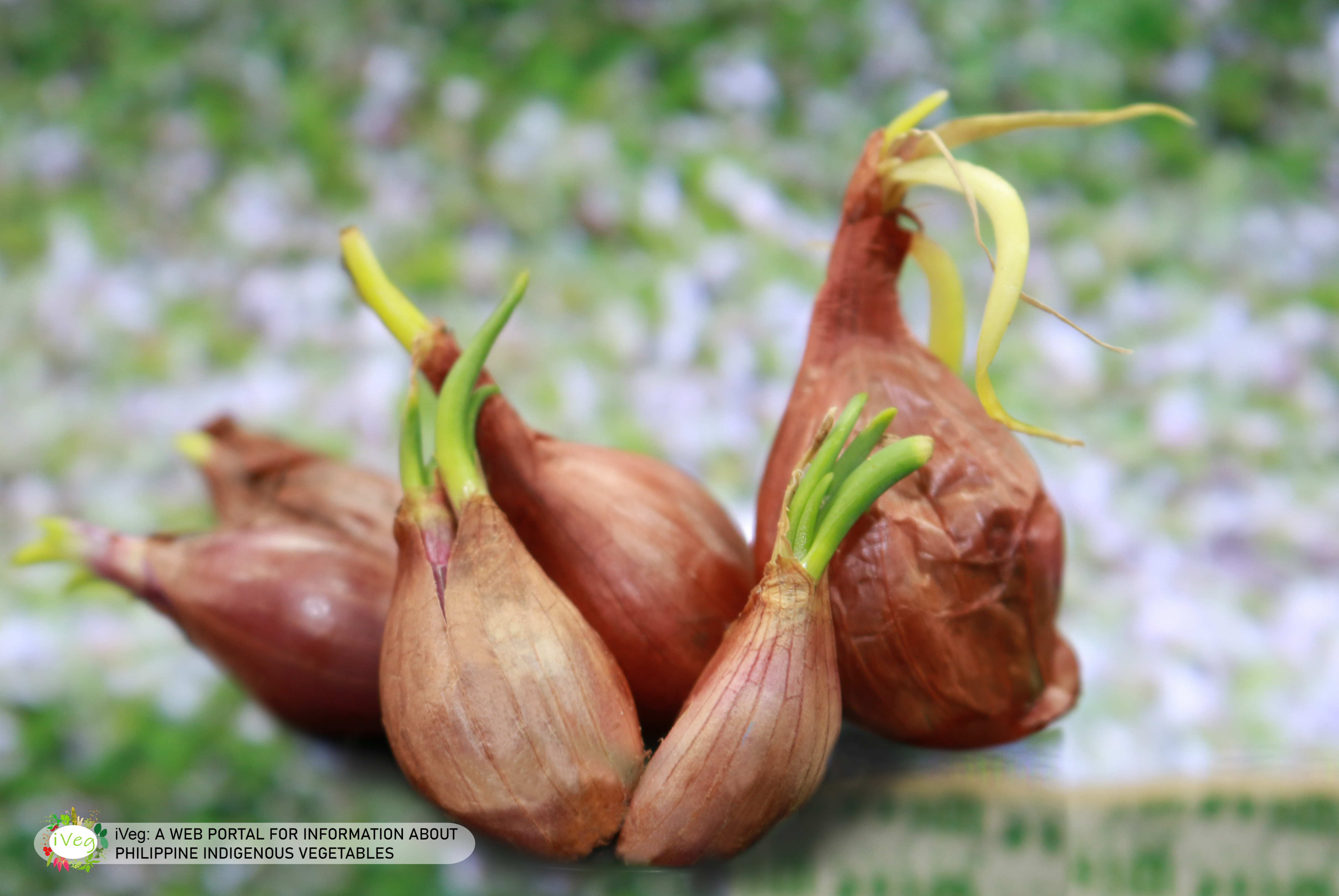Ilocos Norte : lasona
shallots (Allium cepa cv. aggregatum) Family: Amaryllidaceae
Vernacular Names: lasona
Parts utilized as vegetable and availability: all parts; leaves; bulb
Habitat: garden, mountain, upland field, ricefields
Availability: available after rice
Major uses: rekado; panggisa
Dishes:spice, toppings for noodles, kinilaw, sautéed, salad with tomatoes and fish paste, pickled, pinakbet
Pinakbet na Lasuna Gulay
(Shriveled Sauteed Young Shallots Seasoned with Fish Paste)
Elvis Niño Pidut, Brgy. Mabusag Sur, Badoc, Ilocos Norte
Ingredients
• 12-15 whole young shallot plants or lasuna gulay, which are about 35-day-old whole garlic plants (Allium cepa cv. Aggregatum)
• 2-4 tbsp fish paste or bagoong
• 8-10 pcs medium tomatoes or kamatis, sliced
Procedure
1. With a knife, cut bottom part of lasuna gulay in a way that the dry outer layer will also come off.
2. Cut off dry or damaged ends of the leaves. Cut into lengths of about 6 cm.
3. Partially slice the underdeveloped bulbs (bottom of the plant) so that flavor will seep into this thickened part during cooking.
4. Wash tomatoes and slice. Do not discard seeds and juices.
5. In a pot or casserole, pile cut lasuna gulay.
6. Top with tomatoes, squeezing the juices out of the pulp as the slices are spread over the lasuna gulay.
7. Mix bagoong with a small amount of water and pour the mixture into the casserole.
8. Boil until liquid is reduced.
Note: Pinakbet means “pinakulbet”, an Ilocano term, and “pinakubet/kulubot” in Tagalog, meaning shriveled. The acidity of the tomatoes shrivel the pinakbet vegetables. Tomatoes also neutralize or temper the saltiness of the bagoong.
Traditional Pinakbet
(Shriveled Sauteed Mixed Vegetables)
Elvis Niño Pidut, Brgy. Mabusang Sur, Badoc, Ilocos Norte
Ingredients
• 1 pc medium sweetpotato or kaong/camote roots, peeled and cubed (Ipomoea batatas)
• ½ cup cowpeas or utong (Vigna unguiculata ssp. unguiculata)
• 1 pc medium native eggplant or tarong, cubed (Solanum melongena)
• 6-8 pcs native bittergourd or parya, whole round fruits (Momordica charantia)
• ½ cup hyacinth bean or parda (Lablab purpureus)
• ½ cup pigeon pea or kardis (Cajanus cajan)
• ½ cup radish pods/fruits or rabanos (Raphanus sativus)
• 1 pc medium bulb onion or sibuyas, chopped
• 4-5 cloves garlic or bawang, crushed
• 10-12 tomatoes or kamatis, sliced and the pulp squeezed so that the juices come out
• 3-4 tbsp fish paste or bagoong
• Chilli or siling espada or siling pansigang
Procedure
1. In a bowl, arrange the vegetables in layers, distributing the tomatoes (pulp, seeds and juices included) between layers. Top with a final layer of tomatoes.
2. Mix a bit of water with bagoong and drizzle the mixture over the vegetable layers.
3. Cook over low heat.
4. As the vegetables boil, shake the pot a little to allow vegetables and juices to mix.
5. Cover and cook for a bit more.
Note: Pinakbet means “pinakulbet”, an Ilocano term, and “pinakubet/kulubot” in Tagalog, meaning shriveled. The acidity of the tomatoes shrivel the pinakbet vegetables. Tomatoes also neutralize or temper the saltiness of the bagoong.

| Study site: |
Brgy.
Camandingan, Batac, Ilocos Norte
Brgy. Sumader, Batac, Ilocos Norte Brgy. San Agustin, San Nicolas, Ilocos Norte |
|---|